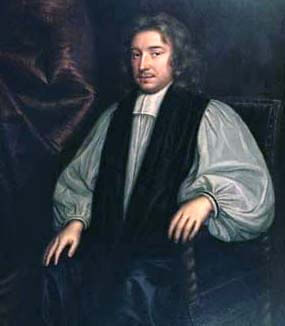The Symbolism of Chess
The Symbolism of Chess
Paper delivered to Bishop Wilkins College SRIA on Tuesday, 18th September 2007 by V.W.Frater D.J. Moore VII°
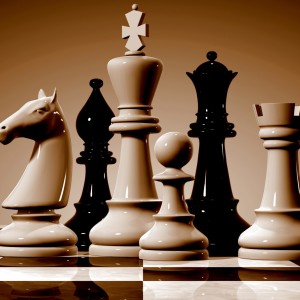
I should say at the outset that I am not particularly good at playing chess. My father was and my son is, so I suppose it must have skipped a generation somehow. What does, however, fascinate me is the symbolism behind the game – the board, the pieces and their moves – for me that is far more interesting than how to do check mate in four moves and that is what I propose to look at tonight.
The game, as most of us are familiar with it, is played on a board of 64 squares. Alternately black or white – or at any rate white and another colour. Like the Mosaic pavement in our lodges this, put simply, is meant to represent the fundamental dualities of night and day, good and bad, life and death etc. So the game itself symbolizes the triumph of good over evil or vice-versa.
The pieces
To look at the pieces: we have a King, a Queen, two Bishops, two Knights and two Castles or Rooks, together with eight pawns – sixteen pieces in all.
In other versions of the game there can be up to 192 squares (sixteen rows of twelve) and it played by twelve pawns with pieces like the Griffon, Cockatrice, Giraffe, Unicorn and Lion.
Origins
Chess probably originated in India in the 6th century AD – possibly before – and indeed the 64 squares (eight by eight) is the mandala (or symbolic representation of the Universe) of the Hindu Goddess Siva or Shiva who is part of the Hindu ‘Trinity’ with Vishnu and Krishna. Then it was a game for four players, known as Chaturanga, in which dice were used to initiate moves and which was about warfare and fate. It was sometimes played on a circular board. The circle as we know represents infinity, having neither beginning or end.
In time the game passed into Persia where it was modified to become a game of intellectual strategy for two players and called Shatranj. It became popular through the Arab world which led to its coming to Spain and from thence throughout Europe as well.
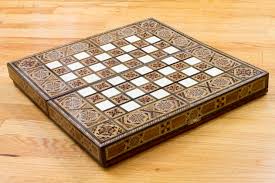
Let’s get back to the concept of eight squares in either direction. If we look at our lecture on numbers: No.8 designates the primitive law of nature , being the first cube, and points out that all men are born equal; it is also esteemed the number most to be desired, being the number of justice. And, of course, we have eight grades in this Society. Eight by eight was deemed the pattern for temples and cities as the number of cosmic perfection, in other words denoting the cosmos in all its possibilities with the forces at work in the universe and in man.
We’ll look at the pieces and their moves in a moment but let me point out one feature at this stage. When a pawn manages to travel the length of the board it is deemed to have ‘arrived’. Pawns don’t often do this but the privilege for so doing is that if the player has lost his Queen, he then gets it back. This is symbolic of the pawn (which represents ordinary man) having travelled through seven stages of initiation to reach the ultimate goal of the eighth grade – paradise regained.
Back to the pieces
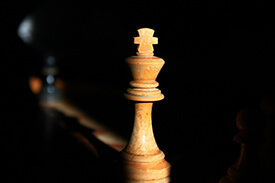 So the pieces: the King represents the Sun, the heart, the forces of law and order. His movements are limited to one square at a time (apart from the process of ‘castling’ which, if you’ve played the game, you’ll know about). The words ‘Check mate’ come from the Arabic ‘Shah maat’ (the king is dead) and from the same Semitic root as the words we use in the Third Degree. Checkmate is not the end of the game in all versions of it.
So the pieces: the King represents the Sun, the heart, the forces of law and order. His movements are limited to one square at a time (apart from the process of ‘castling’ which, if you’ve played the game, you’ll know about). The words ‘Check mate’ come from the Arabic ‘Shah maat’ (the king is dead) and from the same Semitic root as the words we use in the Third Degree. Checkmate is not the end of the game in all versions of it.
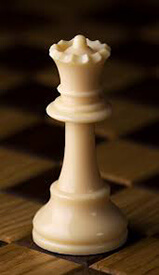 The Queen (in some versions a Counsellor) represents the Moon and is a mover at free will – vertically, horizontally or diagonally. Without her it is very difficult to win a game of Chess.
The Queen (in some versions a Counsellor) represents the Moon and is a mover at free will – vertically, horizontally or diagonally. Without her it is very difficult to win a game of Chess.
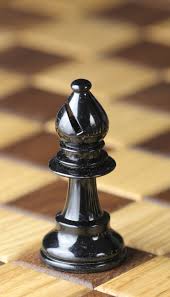 Bishops are sometimes elephants because the Spanish word for Bishop is El Alfil and the Arabic word for elephant is Al-fil and so there was probably some confusion at one point. The end result is the same; he represents the rulers of the spiritual world and moves diagonally to represent the triangle which, as we all know, is a symbol of the Diety. It is said that if he moves on white squares he goes the positive or intellectual route, if on black the devotional or negative way. The piece is said to be existential, representing the feminine principle and ruled by Jupiter.
Bishops are sometimes elephants because the Spanish word for Bishop is El Alfil and the Arabic word for elephant is Al-fil and so there was probably some confusion at one point. The end result is the same; he represents the rulers of the spiritual world and moves diagonally to represent the triangle which, as we all know, is a symbol of the Diety. It is said that if he moves on white squares he goes the positive or intellectual route, if on black the devotional or negative way. The piece is said to be existential, representing the feminine principle and ruled by Jupiter.
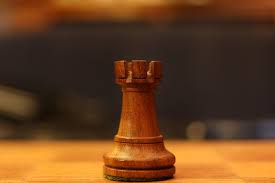 The Castle or Rook (from the Spanish roque) can sometimes be a chariot because of its straight movements (indeed roque is the Spanish word for chariot) and represents the rulers of the temporal world and also by its movements the square – a symbol of earth and matter. In contrast to the Bishop, the Castle portrays the masculine principle and is governed by Saturn.
The Castle or Rook (from the Spanish roque) can sometimes be a chariot because of its straight movements (indeed roque is the Spanish word for chariot) and represents the rulers of the temporal world and also by its movements the square – a symbol of earth and matter. In contrast to the Bishop, the Castle portrays the masculine principle and is governed by Saturn.
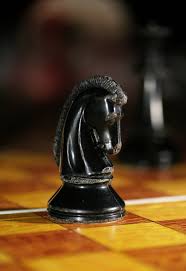 The Knight symbolizes the initiate and has the ability to move one square up then two across or two squares up and one across. Because it may do this in either direction, it is said to be capable of following either the intellectual or devotional route. To illustrate what I mean: movements in the Craft are in a clockwise direction, which represents the temporal world, whilst in the Royal Order of Scotland the perambulations are done widdershins or anti-clockwise to represent a journey through the spiritual realm. In mathematics this concept is known as lemniscate, represented by a figure of eight. Military and chivalric connotations have also been accorded to this piece even associating it with the Knights Templar. It is called the wandering piece or ‘knight errant’ and is ruled by Mars.
The Knight symbolizes the initiate and has the ability to move one square up then two across or two squares up and one across. Because it may do this in either direction, it is said to be capable of following either the intellectual or devotional route. To illustrate what I mean: movements in the Craft are in a clockwise direction, which represents the temporal world, whilst in the Royal Order of Scotland the perambulations are done widdershins or anti-clockwise to represent a journey through the spiritual realm. In mathematics this concept is known as lemniscate, represented by a figure of eight. Military and chivalric connotations have also been accorded to this piece even associating it with the Knights Templar. It is called the wandering piece or ‘knight errant’ and is ruled by Mars.
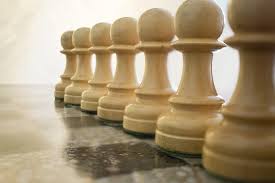 Pawns I have already explained except to say that they are ruled by Venus and Mercury – a pair of lovers.
Pawns I have already explained except to say that they are ruled by Venus and Mercury – a pair of lovers.
Hopefully this goes some way to explaining why a game which I’m sure we have all played and enjoyed has so many singular features, the reasons for which are not immediately apparent.

